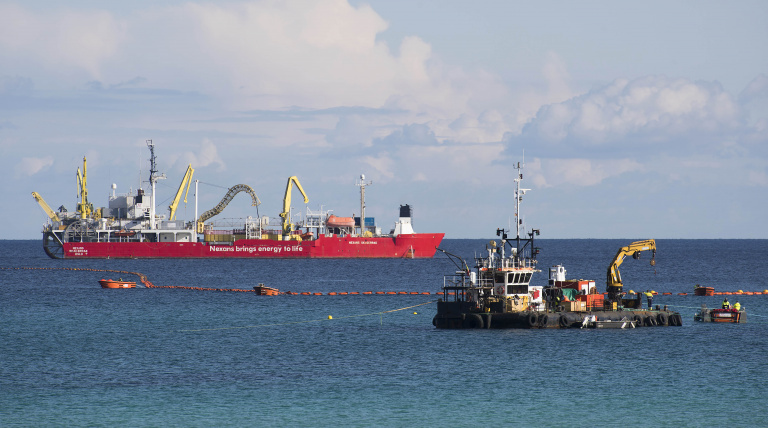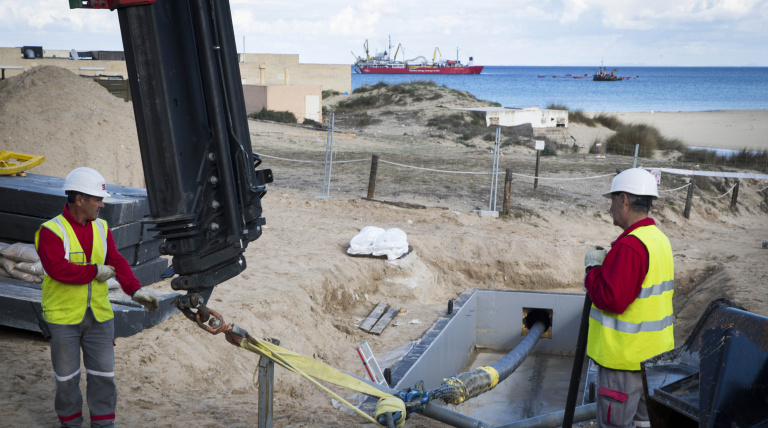- The route includes 41 km of cable laid on the seabed, at a maximum depth of 81 metres, and 12.4 km of cable installed underground in Menorca and 800 metres in Majorca.
- Commissioning is scheduled for the third quarter of 2020.

Red Eléctrica de España has today completed the cable laying works for the new electricity link that will connect the islands of Menorca and Majorca. The cable laying ship ‘Skagerrak’, which began this work last Wednesday in Cala en Bosc (Ciudadela, Menorca), arrived today in Cala Mesquida (Capdepera, Majorca), where the installation of the submarine section of the cable was completed and the next stage took place to drag it ashore to connect it up with the land section of the cable.
This new interconnection, which is scheduled to be commissioned in the third quarter of 2020, will connect Menorca with the entire Balearic Islands’ electricity system and with the Spanish peninsula. With a cost of 84 million euros, it will decisively improve the security and quality of supply in Menorca, facilitate progress in the energy transition of Menorca and the Balearic Islands, maximise the evacuation of renewable energy under safe conditions for the system and reduce CO2 emissions in Menorca.
The link is comprised of a three-core 132 kV submarine-underground cable, weighing about 2,300 tonnes (56.5 kg per metre) and which connects the substations of Ciudadela and Cala Mesquida, in Menorca and Majorca, respectively. The route includes 41 km of cable laid on the seabed, at a maximum depth of 81 metres, and 12.4 km of cable installed underground in Menorca and 800 metres in Majorca. The land sections of the link on the two islands are buried underground.
The shore landing points at both ends of the link are carried out by means of horizontal directional drilling, a technique that allows the installation of an underground conduit/pipe with absolute control. In this way, it is possible to avoid the obstacles of the terrain and guarantee the minimum environmental impact, especially by safeguarding Posidonia Oceanica and other phanerogam meadows that are present in both coastal areas where the landing points are located.
In the case of Cala en Bosc, the horizontal directional drilling has a total length of 310 metres with a maximum depth of 25 metres, while in the case of Cala Mesquida, it has a length of 800 metres, with a submarine route with a maximum depth of 20 metres and a land route section of 276 metres underneath the beach.
For the cable laying operations, the Skagerrak is equipped with a dynamic positioning system and different monitoring devices for accurate cable laying, thus ensuring that the work is performed according to the designed layout and which seeks to avoid any impact on the environment.
Once the entire cable has been laid, work will be conducted until March to protect the submarine link by burying the cable in the seabed using jetting1 and trenching2 techniques. The purpose of this protection is, among others, to maximise the integrity and safety of the link, especially in the face of external aggressions derived from illegal anchoring practices.
_________________________________________
- Jetting. Technique used to protect the cable by directing pressurized water into the sandy seabed to open a channel that allows the cable to fall into it by its own weight to a previously defined minimum depth. Subsequently, the sand removed falls on it again, leaving the cable covered and protected.
- Trenching. Technique used to protect the cable in areas where there is sedimentary rock, and which requires a rock cutter to make a trench and remove the rock in which to bury the cable. Following this operation, the cable is deposited in the trench and subsequently covered and protected with the same rock or, in its absence, with sea sand.

